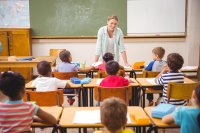Keeping the Focus on the Positive
Paying attention to what was going well for students led a special education teacher to a strengths-based approach to teaching.
Your content has been saved!
Go to My Saved Content.As a special educator with seven years’ experience as a public school teacher and now seven more as a private tutor, I’ve worked with students with huge academic and behavioral challenges. Often the discrepancies between their current performance and what is expected have been so large that anyone could point them out.
And when I was a classroom teacher, I was frequently surrounded by problems that could feel insurmountable: seemingly unattainable standards, hours of meetings, mountains of paperwork, and more.
I found that choosing to focus on these negative things resulted in my feeling frustrated and depleted—burned out. And I realized that often our students who struggle in school are focused on negatives too: Because of academic or behavioral challenges, they come to school every day and have a bad experience.
This light bulb moment made me realize that instead of mirroring students’ attitudes, fears, and anxieties, I needed to show them something different. For this reason, focusing on the positive is one of my most effective teaching techniques.
In fact, research points to teacher support and the identification of positive personal characteristics as the strongest predictors that students will feel a sense of belonging at school, which is essential to their well-being. In focusing on the positive, teachers can foster better academic and personal outcomes for students.
How I Focus on the Positive
Be a cheerleader instead of a critic: I make an effort to focus on positive behavior. Each day, I watch my students to determine what motivates them and get to know what they enjoy outside of school.
Be an observer: Students who struggle immensely with academics are often very talented and motivated in other areas. I ask myself, “What makes this student tick?” or “What motivates them?” or “What special gifts or talents does this student have?” I do this even when processing negative behavior, and once I made this change in my attitude I started to see things differently.
Here are some of my observations:
- A child with extreme dysgraphia, who struggled to write even simple sentences and often had his head down, told the most creative stories.
- One of my students with dyslexia was a talented artist. Her face lit up as she drew lifelike portraits at her desk during the lesson. Another student could take anything apart and put it back together.
- A student with an intellectual disability had the kindest heart. His first thought was always for someone else.
- A student who acted out and frequently disrupted the class when he was given a worksheet excelled when given a project.
- One of my students from a group home who required a behavior aide wrote the most beautiful poetry.
Find ways to link strengths to academics: After searching for strengths, talents, and interests, I look for a way to connect what a student struggles with to a skill they already possess. To facilitate this in the school setting, I gave students leadership roles within the classroom and designed project-based learning. I looked for opportunities to provide choice—from the books that students read to the ways they demonstrated learning.
I even searched for ways to incorporate learning into my behavior management practices. I let my student who enjoyed poetry go to the library and get poetry books, and when he was upset, he would decompress by turning his feelings into free verse.
Make academics more accessible: I use creativity and assistive technology to bridge the gap between talents and academics. I showed my student who enjoyed telling stories how to use voice-to-text software that made the recording of stories possible even when writing was difficult. My artist drew pictures in her notes of what she visualized as we read. I also posted art around the room and “commissioned” art to go with the themes of our units.
Help students find a purpose: I try to make sure each student feels that they have a purpose. In the classroom, I searched for things that were broken—pencil sharpeners, staplers, computers—and let my mechanically inclined student fix them. Students who liked to help and had strong interpersonal skills passed out papers or rewards and were responsible for encouraging others.
I find that so often in teaching things change from year to year just as you are adjusting to them. However, focusing on the positive is timeless and cost-effective. It will not be replaced next year by a fancy new program or shiny new technology. It is the foundation for personalized learning and the key to closing the achievement gap for students who are hard to reach.
Instead of starting with the standards that must be learned, I learned to start with the student in front of me. Through focusing on student strengths, I’m able to build the resiliency and interest in my students that’s necessary to achieve academic objectives. By focusing on the positive, I build up the child in front of me to be the best version of themselves.
